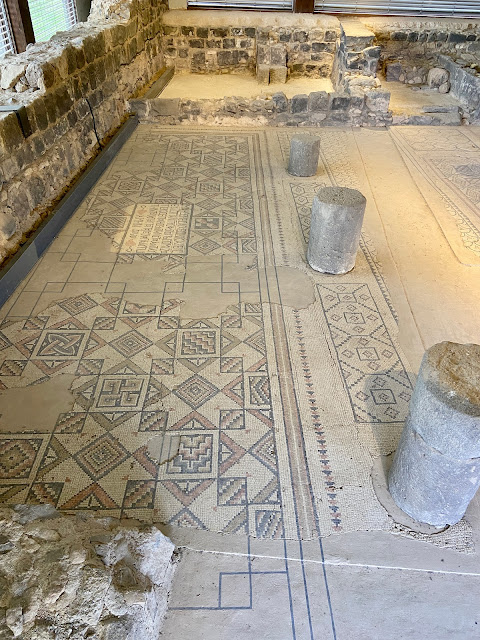I just don't know where the months
have gone since our return from 2022 Israel tour.
As I can, I will try to tell the story
of the places we visited.
This trip we were able to visit
Hamat Taverna National Park in Tiberias.
We had been chased all day by rain and a storm
and when we got out of the bus this beautiful rainbow
dipping into the Sea of Galilee greeted us.
There are hot springs located here
and the word Hamat is Hebrew for hot.
Hamat was mentioned as early as the thirteenth century BCE
by an Egyptian traveler as a "'tourist site."
In Joshua 19:35 it is mentioned as the southernmost
fortified city of the tribe of Naphtali.
In the Roman period, the city of Tiberius
was founded and swallowed up Hamat.
Most of the city has yet to be excavated.
A covered building protects the remains of the synagogue
near the southern wall of the city. The synagogues were built
over the ruins of older sites. The first was built around 230 CE.
Here is a piece of the mosaic from a later building in the third
or fourth century CE. building.
During much of this time the synagogue here
was the seat of the Jewish Sanhedrin.
The intricate mosaics are beautiful.
Here is the southern panel with the Holy Ark depicted
along with Jewish symbols such as two seven-branched candelabra,
a shofar (ram's horn) and a lulav (palm frond).
The northern panel depicts 2 lions flanking nine inscriptions
in Greek dedicated to the donors.
These floors are the earliest such floor ever found
in a synagogue in Israel.
This synagogue was destroyed in an earthquake
in the fifth century.
A third synagogue was built and lasted until the 8th century.
The hot steam baths were used by the Arabs and built in 1780
and used until the 1940's.
Our guide, Yossi, treated us to the sound
of the "music from the baths"
from the building of Hamam Suleiman
when the hot springs were used for their medicinal purposes.



















































